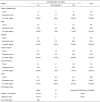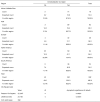Regional variations in acceptance, and utilization of minimally invasive spinal surgery techniques among spine surgeons: results of a global survey
- PMID: 32195433
- PMCID: PMC7063310
- DOI: 10.21037/jss.2019.09.31
Regional variations in acceptance, and utilization of minimally invasive spinal surgery techniques among spine surgeons: results of a global survey
Abstract
Background: Regional differences in acceptance and utilization of MISST by spine surgeons may have an impact on clinical decision-making and the surgical treatment of common degenerative conditions of the lumbar spine. The purpose of this study was to analyze the acceptance and utilization of various minimally invasive spinal surgery techniques (MISST) by spinal surgeons the world over.
Methods: The authors solicited responses to an online survey sent to spine surgeons by email, and chat groups in social media networks including Facebook, WeChat, WhatsApp, and Linkedin. Surgeons were asked the following questions: (I) Do you think minimally invasive spinal surgery is considered mainstream in your area and practice setting? (II) Do you perform minimally invasive spinal surgery? (III) What type of MIS spinal surgery do you perform? (IV) If you are performing endoscopic spinal decompression surgeries, which approach do you prefer? The responses were cross-tabulated by surgeons' demographic data, and their practice area using the following five global regions: Africa & Middle East, Asia, Europe, North America, and South America. Pearson Chi-Square measures, Kappa statistics, and linear regression analysis of agreement or disagreement were performed by analyzing the distribution of variances using statistical package SPSS Version 25.0.
Results: A total of 586 surgeons accessed the survey. Analyzing the responses of 292 submitted surveys regional differences in opinion amongst spine surgeons showed that the highest percentage of surgeons in Asia (72.8%) and South America (70.2%) thought that MISST was accepted into mainstream spinal surgery in their practice area (P=0.04) versus North America (62.8%), Europe (52.8%), and Africa & Middle East region (50%). The percentage of spine surgeons employing MISST was much higher per region than the rate of surgeons who thought it was mainstream: Asia (96.7%), Europe (88.9%), South America (88.9%), and Africa & Middle East (87.5%). Surgeons in North America reported the lowest rate of MISST implementation globally (P<0.000). Spinal endoscopy (59.9%) is currently the most commonly employed MISST globally followed by mini-open approaches (55.1%), and tubular retractor systems (41.8%). The most preferred endoscopic approach to the spine is the transforaminal technique (56.2%) followed by interlaminar (41.8%), full endoscopic (35.3%), and over the top MISST (13.7%).
Conclusions: The rate of implementation of MISST into day-to-day clinical practice reported by spine surgeons was universally higher than the perceived acceptance rates of MISST into the mainstream by their peers in their practice area. The survey suggests that endoscopic spinal surgery is now the most commonly performed MISST.
Keywords: Lumbar minimally invasive spinal surgery; regional variations.
2020 Journal of Spine Surgery. All rights reserved.
Conflict of interest statement
Conflicts of Interest: Jorge Felipe Ramírez León is shareholder & President of Board of Directors Ortomac, Colombia, consultant Elliquence, USA. The senior author designed and trademarked his inside-out YESS™ technique and receives royalties from the sale of his inventions. Indirect conflicts of interest (honoraria, consultancies to sponsoring organizations are donated to IITS.org, a 501c 3 organization).
Figures







References
-
- Minamide A, Simpson AK, Okada M, et al. Microendoscopic Decompression for Lumbar Spinal Stenosis With Degenerative Spondylolisthesis: The Influence of Spondylolisthesis Stage (Disc Height and Static and Dynamic Translation) on Clinical Outcomes. Clin Spine Surg 2019;32:E20-6. 10.1097/BSD.0000000000000710 - DOI - PubMed
LinkOut - more resources
Full Text Sources
